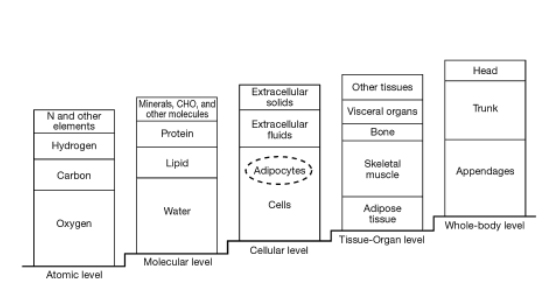What’s the human body made up of? It’s not a easy question to answer, because you can see it in many ways. Components ranging from elements to tissues and organs are the building blocks that gave mass, shape and function to all living things. Body composition analysis techniques allow scientists to study how these building blocks function and change with age and metabolic stage. Scientists from different disciplines, as well as healthcare workers, rely on body composition measurements to research for diagnostic purpose.
figure 1-1 Five body composition levels The molecular level consists of six major components: water, lipid (fat), protein, carbohydrates, bone minerals and soft tissue minerals. Various models of the molecular level can be created that range from two to six components. The two-component model, which includes FM (fat mass) and FFM (fat free mass) is presently the most wide applied model in body composition analysis research. Models include three or more components are referred as multi-component models. These models further divided the FFM into additional components. In the three-component model, the FFM is divided as lean soft tissue and bone mineral. The widely used four-component(4C) model partitions FFM into water, protein and mineral components. Models are available that up to six molecular-level components.
figure 1-2 Representative multi-component models In physical fitness or health care industry, we use 4C model commonly. That means the body is consist of water, fat, protein and bone mineral. Since muscle is a combination of water and protein. The 4 C model should be expressed like the follows:
|



